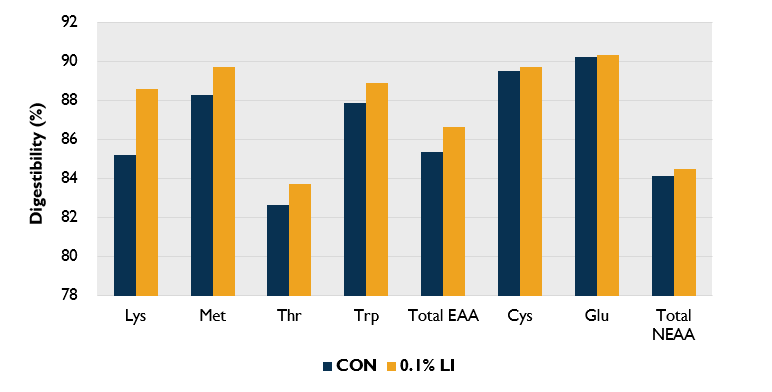



Enhancing pig development with Lysophospholipids: a nutritional breakthrough
Bioactive lipids can enhance piglet development by improving nutrient absorption, supporting gut health with a healthy immune systemIntroduction
The swine industry continually seeks innovative solutions to improve the health and growth of piglets. One such innovation gaining traction is the use of lysophospholipids (LPLs) in swine nutrition. LPLs, a class of bioactive lipids, play a crucial role in various metabolic and physiological processes. In this article, we will discuss their positive effect on nutrient absorption, observed to enhance the overall performance from weaning to slaughter.
Early piglet development is a crucial phase in production, influencing the animal's future health and productivity. Targeted nutrition during this early period, especially immediately after weaning, is vital to ensure optimal growth.
Pathway Intermediates’ research demonstrates that intestinal support during this early development stage reduces stock variation post-weaning, leading to optimized performance and improved profitability, such as faster days to slaughter.
Lysophospholipids
Lysophospholipids are a diverse group of lipid molecules. They are produced when phospholipids, which are major constituents of cell membranes, are broken down by enzymes called phospholipases. LPLs are composed of a glycerol backbone, a single fatty acid chain, and a phosphate group. They are known to be versatile molecules with diverse functions, including acting as emulsifiers, solubilising agents, and signalling molecules. They are produced naturally during normal metabolic processes as well as being commercially produced for inclusion in the pig feed.
The in-house research on one of the primary roles of LPLs in the body has confirmed that this molecule is an aid in absorption and transport of post digestive nutrients across the small intestine. LPLs are amphipathic, possessing both hydrophilic and hydrophobic regions, allowing them to interact with lipids and water-soluble molecules in the gastrointestinal tract. In this situation, LPLs form very small micelles which enhance fats, and fat-soluble vitamins, to be transported to the intestinal epithelial cells for absorption. This aids in piglet production by assisting the immature gut in digesting dietary fats.
Sow milk and piglet performance
Lipidol contains LPLs, which can enhance the absorption of nutrients into epithelial cells in the gastrointestinal tract. An experiment with North Carolina State University indicated a range of benefits in both the sow and the piglets (Jang et al., 2020; J. Anim. Sci. skaa227). Results of this experiment showed that body weight loss of sows numerically reduced when sows were fed the diet containing 0.05% Lipidol Ultra compared to sows in the control group. In addition, litter weight of sows fed Lipidol Ultra was significantly greater than the control group (81.2 vs. 75.0 kg; P = 0.047) on day 18 post farrowing. The improvement in litter weight was mainly due to the improved milk quality of sows. Sows fed Lipidol Ultra had greater IgG content in milk compared to the control group (1.94 vs. 1.14 g/L; P = 0.092). Based on findings of this experiment, positive effects of feeding lysophospholipids will not only improve the reproductive performance of sows, but also support the health growth of piglets in the further production line.
Enhanced Nutrient Absorption
One of the primary benefits of Lipidol in piglet nutrition is their ability to improve nutrient absorption. Lipidol increase the fluidity of cell membranes in the small intestine, which allows protein channels to become more efficient in nutrient uptake.

Healthy Immune System Support
A strong immune system is vital for piglet health and development. Changes in sow milk colostrum quality is known to assist in the potential immunomodulatory effects in post weaning piglets. Such effects have been recorded as a lower impact of common infections and diseases in post weaning piglets by veterinarians in the field. Studies from human research have indicated an increase in blood plasma concentrations of lysophosphatidylcholine, increasing macrophage activity.
Anti-Inflammatory Properties:
Some LPLs, such as lysophosphatidic acid (LPA), possess anti-inflammatory properties. By modulating the immune response in the gut, they have been reported to reduce inflammation and support a healthy intestinal environment. This is especially important for preventing conditions like enteritis in pigs, which is known to impact the intestine structure, integrity and absorption capacity.
Lysophospholipids and formulations:
Dietary inclusion of Lipidol in monogastric formulations has shown a wide range of benefits: Including, effective financial returns, improved animal performance, and sustainable production. Pathway Intermediates’ matrix values gives rise to a saving on formulation input costs to further optimise diet performance potential on farm. Our commercial observations indicate that the evaluation on sustainable focus, for example, can yield a reduction of 1.5-3.6kg of soya in finisher feeds and there are other feeds to review in the pig cycle. LPLs in combination with the boost in performance during the post weaning phase, can provide a significant shift in the herd profitability.
Conclusion
The use of LPLs in piglet nutrition is an exciting and evolving field of study. Research suggests that these bioactive lipids have the potential to enhance piglet development by improving nutrient absorption, supporting gut health with a healthy immune system. As the swine industry continues to seek sustainable and effective methods for improving piglet growth and well-being, LPLs hold promise as a nutritional breakthrough.








